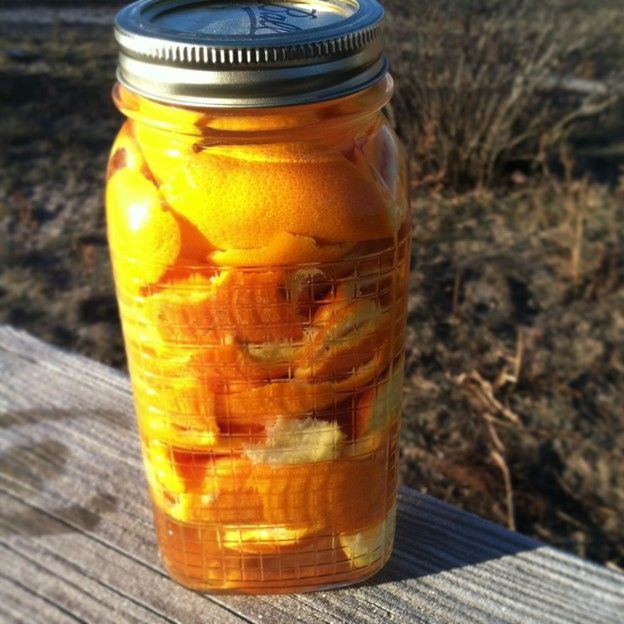Enjoying Outside, Inside - Spring Cleaning the Way Nature Intended

Orange Peel Vinegar All-purpose Cleaner by Jen Vogt
I love a clean house and the fresh spring air and smell of things blooming outside my window always motivates me to deep clean corners that might have been forgotten about during winter. Indoor air quality is often several times worse than outdoor air quality for various reasons but chemicals in store bought cleaning products are part of that reason. The chemicals found in commercial cleaners can trigger asthma attacks even in healthy people and ultimately affect our environmental health because they can end up in our water supply and our water ways. Besides, I hate the smell of bleach so I decided to research some natural and homemade cleaners that will clean just as well without using caustic or irritating chemicals. Turns out, there are a TON of cleaners you can make yourself in your own kitchen to clean and freshen your home. It’s almost safe to call some of them “recipes” since most of them are made with things from your kitchen!
I think the majority of households nowadays probably have a self-cleaning oven but the smell of that process is nearly as noxious as the chemicals used to clean non-self-cleaning ovens. To get yours sparkling whether you have the self-cleaning version or not, wet the inside of the oven with a spray bottle of just water. Then sprinkle a thick layer of baking soda anywhere that needs to be cleaned, it’s always the bottom of the oven at my house. If it’s really bad, put a thick, about a quarter of an inch, layer of baking soda and water paste over the cooked-on spot and let set for a couple of hours. Then, wipe away the scorched lasagna or apple pie that spilled over. To clean pots, pans and messy casserole dishes, cut a lemon in half and use some coarse salt to scrub them clean. When you’re done, hang on to that lemon and keep reading, you’ll find out what else you can use it for.
If you need to scrub soap-scummy sinks, tubs and showers, you can make your own scouring powder by mixing two parts baking soda, one part salt and one part borax and then clean away all the yucky stuff. To clean the toilet, pour in one cup of baking soda and let set for an hour. Then, pour in one cup white vinegar, wait five minutes and then flush. You shouldn’t even need to scrub it and it helps clean the drain pipe as well!
To make an all-purpose spray cleaner fill a mason jar with orange peels and pour undiluted white vinegar over them. Cover and let set for a few days to a couple of weeks and then pour off and reserve the vinegar. Put into a spray bottle and use to mop floors, freshen upholstery, and disinfect surfaces. You can even dilute it and use it to clean glass. The vinegar smell disappears shortly after using and you’ll be left with citrus-y freshness. If a surface is really greasy, pouring straight white vinegar or rubbing it with lemon juice will break up the grease and make it easy to wipe away. Remember that lemon half from earlier? A super simple way to freshen your garbage disposal is by throwing half of a lemon down and running it for a bit. Your sink will smell as good as it looks.
Baking soda also absorbs odors and if you have a less than fresh rug or sofa, sprinkle baking soda all over it and let it set overnight. Simply vacuum up the soda in the morning and it’ll instantly smell fresher. You can even use it to freshen stinky shoes and other not so easily washed items by placing them in a bag with the baking soda, seal and let set overnight. Arm and Hammer even sells their soda in a special package made to keep in the refrigerator to keep it from getting stale smelling. If you have a pet that maybe had an accident, very gently stir (don’t shake!) together, eight ounces of 3% hydrogen peroxide (the same kind that’s in your medicine cabinet), three tablespoons of baking soda and a drop of dishwashing liquid. Spray on the stain, watch it dissolve, and then vacuum when dry. However, the magic to this concoction is the fizzing action and it only works when freshly mixed so you’ll have to remake it if you need to use it again. Use caution though because the hydrogen peroxide can bleach darker colors so always test it in an inconspicuous spot first.
When you’re done and your house is clean, you won’t feel like you need a shower to wash the chemicals off.
Bonus tip – switching from paper towels to microfiber cloths will not only save you money and you’ll feel better about being able to reuse them. Speaking of reusing, newspaper also cleans glass really well and doesn’t leave dust behind like paper towels do.
-Kristie Ehrhardt; kehrhardt@tuleyome.org
Tuleyome Land Conservation Program Manager
RECENT ARTICLES






